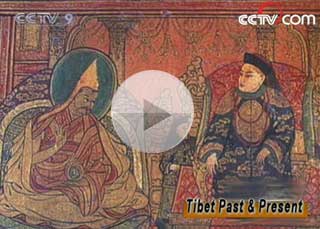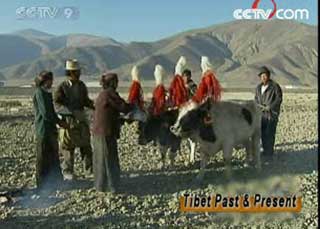------Program code: DO-080504-03889 (what's this?)
Source: CCTV.com
05-04-2008 14:32
The Protection of Tibetan Culture
Native Tibetan culture has developed from two main sources; the Tubo culture of the Yalong River valley at the heart of the Yarlung Zangbo River basin; and the ancient Zhangzhung culture of the western part of the Qinghai-Tibet Plateau. In the 7th-century, at the time of the reign of Songtsan Gampo, Buddhism was introduced into Tubo from the Central Plains, India and Nepal. From then on, Tibetan Buddhism, with its unique features, began took shape.
 |
| Watch Video: Part 2 |
At the same time, the development of Tibetan culture was being heavily influenced by the Indian and Nepalese cultures of South Asia, the Persian and Arabic cultures of West Asia and, in particular, the Han culture of the Central Plains. Under these influences, a high level of development was achieved by Tibetan architecture, sculpture, painting, decoration, arts and crafts, as well its music, dance, theatre, spoken and written language, written literature, oral literature, medicine and astronomy.
In Tibetan, the place is called Pabangka, which means a building on a huge rock.
It was here, in the 7th century, that a senior official by the name of Thonmi Sambhota created the first 30 letters of the Tibetan written language. In doing so, he drew on elements of Sanskrit and the ancient Zhangzhung language. The letters developed into a script that was used in Tibetan-inhabited areas. However, only a small proportion of traditional Tibetan society mastered the script. These were the monks and aristocrats, who had access to education, not the ordinary people. The books and records, since they came from the monasteries, were mostly related to religion. Buddhism held sway in Tibetan culture for a long time. The cultural dominance exercised by the monks and aristocrats was typical of the theocratic feudal society of mediaeval times.
 |
The means of production and the cultural and educational infrastructure were monopolized by a small number of upper-class monks and aristocrats. As for the vast majority – the serfs and slaves who accounted for 95 percent of the Tibetan population – they lived in abject poverty. Their basic right to subsistence was not guaranteed and they were denied access to culture and education.
This situation lasted for many centuries, until the Democratic Reform of 1959.
Following the Democratic Reform in 1959, education was popularized and the Tibetan language became widely used in every aspect of social life. The resolutions, laws and regulations adopted by the People’s Congress of Tibet Autonomous Region, and the official documents and public notices issued by local governments at all levels and government departments, were drafted in both the Tibetan and the Han languages. Lawsuits are now dealt with in Tibetan. The Tibetan and Han scripts are both used for official seals, certificates and letter headings, the signboards of government offices, factories, mines, schools, railway stations, airports, shops and hotels, the names of streets, and road signs.
